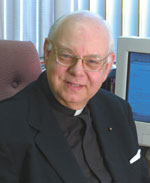Fourth Sunday of Easter / Msgr. Owen F. Campion
The Sunday Readings
 The Acts of the Apostles supplies the first reading.
The Acts of the Apostles supplies the first reading.
It gives a glimpse into the way of life of St. Paul as he moved across Asia Minor proclaiming the Gospel of Jesus.
Evidently, he first went to synagogues, which is not surprising. He was Jewish—of Jewish descent and background—and was well educated in the Jewish culture and religion of the time.
Quite likely, he would have been more comfortable, but also more likely to be heard, in such surroundings as synagogues.
It also is clear that he was not always met by universal acceptance, although it would not be accurate to say that he attracted no converts from among the Jews whom he met. He drew many of the Jews into the ranks of the Christians. He also attracted Gentiles.
But these details are only secondary to the story.
The point of this reading is that the word of God, pronounced by Jesus, continued to be spoken and received long after the Ascension.
Moreover, it was proclaimed by an Apostle, and also by Barnabas, who was a disciple of an Apostle.
Salvation went on, and still goes on. Through the Apostles, Jesus continued to speak to the people.
The Book of Revelation furnishes the next reading.
It is filled with symbolism, but its meaning is clear. Among those saved by Jesus are people from every nation. Their number is great. They are baptized, wearing the white robes of baptism. They carry the palm branches of martyrs. They have kept their faith despite persecution. Their sins have been washed away by the Lord, precisely by the sacrificial blood shed by the Lord on Calvary.
The Good Shepherd leads them. He rescues them from the heat of the day and the dryness of earthly life.
St. John’s Gospel provides the last reading.
This Gospel reading, read immediately after the passage from Acts, also presents Jesus as the Good Shepherd.
For an audience overwhelmingly agrarian, as was the audience to which Jesus preached, imagery built on sheep herding and shepherds was easily understood by the people.
This reading states that the sheep know the shepherd. In turn, the shepherd knows them. It implies a relationship of closeness and trust. No one can snatch any sheep away from the shepherd.
In a great testament of self-identity, Jesus proclaims oneness with the Father. The sheep belong to the shepherd because of the Father’s will—and his love—to keep them near and protect them from peril.
Moving beyond symbolism, the readings say that the shepherd gives eternal life. His sheep will never perish.
Reflection
This weekend, the Church once again calls us to celebrate the Resurrection as it begins the fourth week of proclaiming the exciting news that it first pronounced at Easter. Jesus Christ lives! Alleluia!
Through the readings this weekend, and through those of the preceding weeks of Easter, the Church essentially makes two points.
The first point is that Jesus lives, and in the sublime fact of the Resurrection is evidence that Jesus is God, the Son of God, the eternal Father.
Resurrected, Jesus is totally unique among humans. As God, Jesus is the bearer of life, truth, peace and joy. There is no substitute for the Lord.
The second point, which was made this weekend and in past weeks, is that the word of Jesus, and salvation in Jesus, continues today. They did not cease with the Ascension or the end of the first generation of Christianity.
Jesus lived in the preaching and good works of the Apostles, such as Paul, and of their followers and successors, such as Barnabas.
Through them all, Jesus touched, and still touches, people.
Emphasizing these points, the Church presents us with its basic belief that Jesus is God. In Jesus are truth and life. He is with us still. †
 The Acts of the Apostles supplies the first reading.
The Acts of the Apostles supplies the first reading.